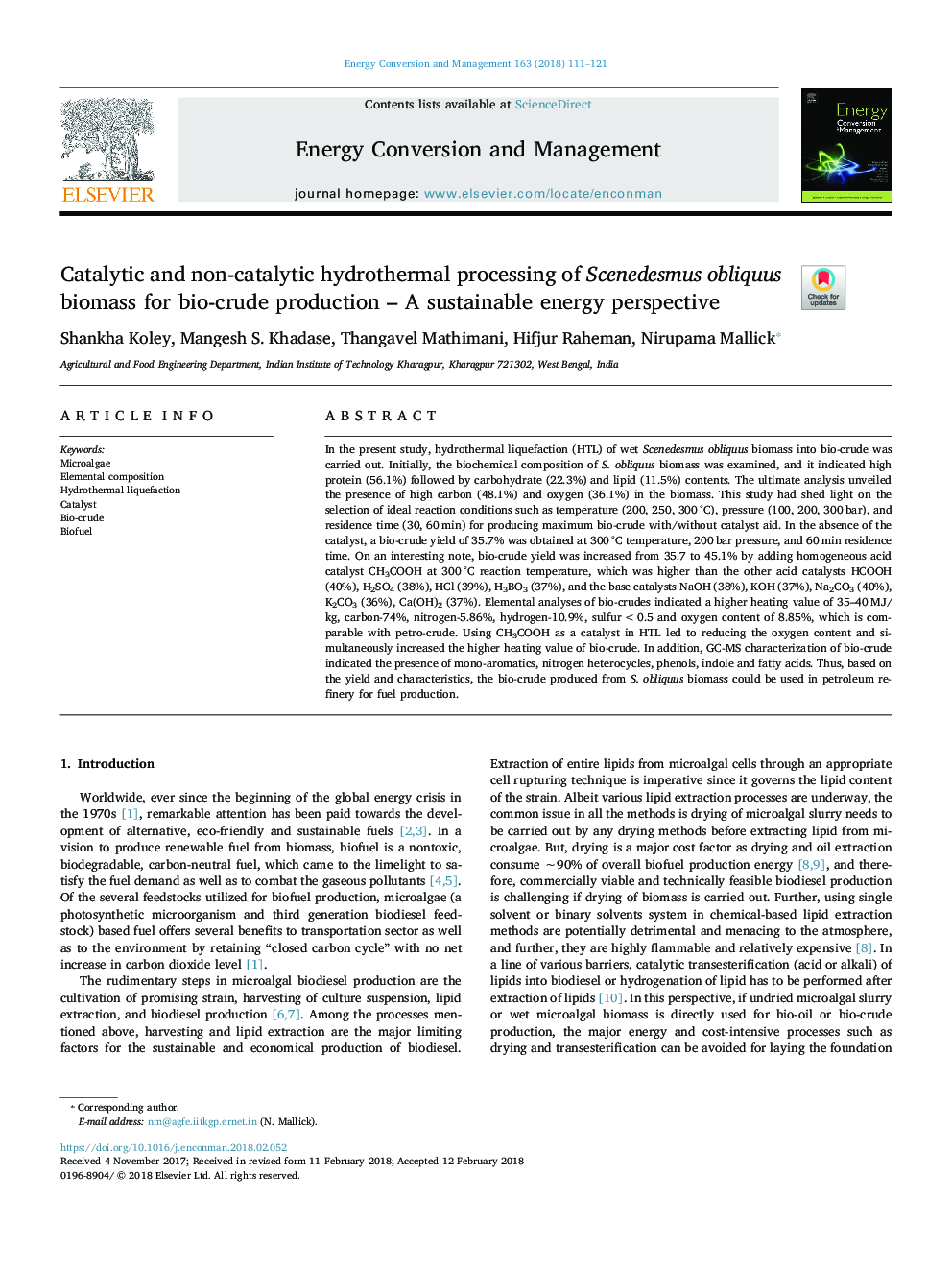| کد مقاله | کد نشریه | سال انتشار | مقاله انگلیسی | نسخه تمام متن |
|---|---|---|---|---|
| 7158798 | 1462799 | 2018 | 11 صفحه PDF | دانلود رایگان |
عنوان انگلیسی مقاله ISI
Catalytic and non-catalytic hydrothermal processing of Scenedesmus obliquus biomass for bio-crude production - A sustainable energy perspective
دانلود مقاله + سفارش ترجمه
دانلود مقاله ISI انگلیسی
رایگان برای ایرانیان
کلمات کلیدی
موضوعات مرتبط
مهندسی و علوم پایه
مهندسی انرژی
انرژی (عمومی)
پیش نمایش صفحه اول مقاله

چکیده انگلیسی
In the present study, hydrothermal liquefaction (HTL) of wet Scenedesmus obliquus biomass into bio-crude was carried out. Initially, the biochemical composition of S. obliquus biomass was examined, and it indicated high protein (56.1%) followed by carbohydrate (22.3%) and lipid (11.5%) contents. The ultimate analysis unveiled the presence of high carbon (48.1%) and oxygen (36.1%) in the biomass. This study had shed light on the selection of ideal reaction conditions such as temperature (200, 250, 300â¯Â°C), pressure (100, 200, 300â¯bar), and residence time (30, 60â¯min) for producing maximum bio-crude with/without catalyst aid. In the absence of the catalyst, a bio-crude yield of 35.7% was obtained at 300â¯Â°C temperature, 200â¯bar pressure, and 60â¯min residence time. On an interesting note, bio-crude yield was increased from 35.7 to 45.1% by adding homogeneous acid catalyst CH3COOH at 300â¯Â°C reaction temperature, which was higher than the other acid catalysts HCOOH (40%), H2SO4 (38%), HCl (39%), H3BO3 (37%), and the base catalysts NaOH (38%), KOH (37%), Na2CO3 (40%), K2CO3 (36%), Ca(OH)2 (37%). Elemental analyses of bio-crudes indicated a higher heating value of 35-40â¯MJ/kg, carbon-74%, nitrogen-5.86%, hydrogen-10.9%, sulfur <0.5 and oxygen content of 8.85%, which is comparable with petro-crude. Using CH3COOH as a catalyst in HTL led to reducing the oxygen content and simultaneously increased the higher heating value of bio-crude. In addition, GC-MS characterization of bio-crude indicated the presence of mono-aromatics, nitrogen heterocycles, phenols, indole and fatty acids. Thus, based on the yield and characteristics, the bio-crude produced from S. obliquus biomass could be used in petroleum refinery for fuel production.
ناشر
Database: Elsevier - ScienceDirect (ساینس دایرکت)
Journal: Energy Conversion and Management - Volume 163, 1 May 2018, Pages 111-121
Journal: Energy Conversion and Management - Volume 163, 1 May 2018, Pages 111-121
نویسندگان
Shankha Koley, Mangesh S. Khadase, Thangavel Mathimani, Hifjur Raheman, Nirupama Mallick,